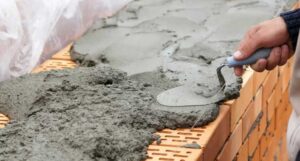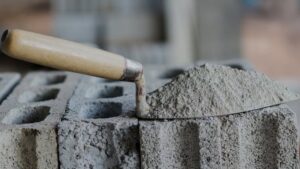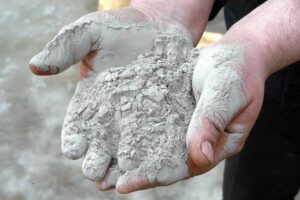
The Ukrainian cement market has stabilized after sharp fluctuations in 2021–2023, but production volumes remain almost half of what they were before the war. This is stated in an analysis by Experts Club, prepared in collaboration with the Ukrcement association.
In 2021, cement production reached 11 million tons, fell to 5.4 million tons in 2022, recovered to 7.43 million tons in 2023, and to 7.93 million tons in 2024. According to manufacturers’ estimates, the “ceiling” in 2025 will be around 8 million tons.
Consumption: 10.6 million tons in 2021, 4.5 million tons in 2022, 6.2 million tons in 2023, and 6.3 million tons in 2024. Thus, the market has stabilized at 6–6.5 million tons, which is about half of pre-war demand.
The structure of demand has changed: instead of residential and commercial construction, infrastructure and defense projects dominate — fortifications, shelters, urgent repairs of roads and bridges. Demand is additionally supported by state programs, including “єОселя.”
In 2025, experts expect stable “military” demand to continue, sensitive to budget financing and donor assistance.
Experts Club is a Ukrainian analytical center specializing in research on economics, energy, macroeconomics, infrastructure, and export-import relations.
A condensed version of the Experts Club’s cement market study is available at https://expertsclub.eu/rynok-czementu-ukrayiny-doslidzhennya-experts-club/
The Ukrcement Association brings together Ukraine’s leading cement producers.

The Experts Club information and analytical center, with the assistance of the Ukrainian Cement Manufacturers Association (Ukrcement), has conducted an analysis of the Ukrainian cement industry.
Over the past five years, the Ukrainian cement industry has experienced a peak in production in 2021, a sharp decline in 2022, a gradual recovery in 2023, and stabilization in 2024. However, the current level is still far from pre-war indicators.
According to trade union and industry reviews, output was about 11 million tons in 2021, fell to 5.4 million tons in 2022, recovered to 7.43 million tons in 2023, and reached 7.93 million tons in 2024. In 2025, manufacturers are talking about an actual “ceiling” — approximately 8 million tons under current risks and logistics, which is likely to be the maximum figure.
The dynamics of domestic cement consumption show a similar trend of “decline and normalization.” In 2021, before the full-scale invasion, consumption was around ~10.6 million tons. In 2022, the cement market fell sharply to approximately 4.5 million tons, rose to 6.2 million tons in 2023, and stabilized at around 6.3 million tons in 2024. Thus, the country approached a stable level of “war” demand, which is almost half of the pre-war level, within the range of 6–6.5 million tons.
The structure of demand has changed: the share of traditional residential and commercial construction has given way to infrastructure and defense projects. The key short-term drivers are fortification works, shelters, emergency repairs of roads and bridges, as well as targeted housing programs such as “єОселя,” which supported demand in 2023–2024, although they did not return it to the 2021 level. The market expects demand to remain stable in 2025, sensitive to the volume of budgetary and international financing.
Amid declining domestic demand, a natural step to support production capacity utilization was the gradual reorientation of part of the cement output to foreign markets. In 2021, cement exports amounted to about 971,000 tons (9% of production), and in 2024, about 1.7 million tons (21.3% of production). The main destinations remain neighboring countries—Poland, Romania, Hungary, and Moldova—as confirmed by both statistical data and industry estimates. The industry has repeatedly emphasized that as soon as domestic consumption begins to grow, the export share will decline in favor of Ukrainian construction sites.
Imports, on the contrary, have declined. After approximately 1 million tons in pre-crisis 2020, deliveries in 2024 decreased to ~40 thousand tons (including niche items such as white cement). This was also influenced by anti-dumping duties: against Turkey — 33–51% (in effect until September 2026), and against Russia/Belarus/Moldova, measures have been extended until 2030. Under the current conditions, when production capacities and logistics are adapted to the “military” level of consumption, demand is fully covered by domestic resources.
The market structure in 2024–2025 is highly concentrated. The key producers are PJSC Ivano-Frankivskcement, the CRH group (after the AMCU approved the deal to acquire CRH’s Dyckerhoff/Buzzi assets — PJSC VIPCEM, Podolsky Cement JSC, Mykolaivcement PJSC, Cement LLC) and Kryvyi Rih Cement PJSC. Despite market discussions, legal disputes, and attention from antitrust authorities—which is to be expected for transactions of this scale—the CRH deal creates potential for integration into global production and logistics chains, attracting new investments, modernizing production, and raising the standards of the competitive environment. In the context of the country’s future large-scale recovery, the agreement opens up opportunities to strengthen supply stability, improve product quality, and develop a competitive environment.
Who is currently driving domestic consumption? In peacetime, the main stabilizers of demand were mass housing construction and infrastructure. In 2023–2025, basic demand will be driven by roads and engineering structures (including fortifications and shelters), municipal and energy facilities, selective reconstruction projects, as well as the private sector — repairs and local construction.
Road construction is an important factor in economic and social development. The introduction of the latest technologies, the use of high-quality materials, and compliance with environmental requirements are key aspects of the successful development of this industry.
The development of the construction and repair of cement concrete roads based on cement mixtures can play a key role in stimulating stable cement consumption in conditions of war and reconstruction. This infrastructure direction makes it possible to maintain the production capacity of enterprises, jobs, and economic activity, despite a significant reduction in residential and commercial construction. Thanks to their durability and endurance, cement concrete pavements are the optimal solution for both military and civilian logistics. The implementation of such projects not only ensures constant demand in the industry, but also the development of related sectors, creating a multiplier effect for the economy even in crisis conditions. This issue will be the focus of a specialised seminar organised by NIRI and the Ukrcement Association on 15-16 October 2025, where the advantages and role of cement concrete solutions in the reconstruction of Ukraine will be discussed (details at ukrcement.com.ua).
In terms of sales channels, the market remains predominantly B2B: most of the cement is purchased by contractors, road and infrastructure companies, large developers, reinforced concrete manufacturers, and concrete plants. The B2C channel (retail chains of building materials, small contractors) continues to play a significant role in repairs and low-rise construction, but in terms of total volume, it is inferior to the project segment. Industry reviews of construction projects and reports on fortification works in 2024–2025 provide further confirmation of the “infrastructure” shift.
The geography of foreign sales shows a stable “corridor” and proximity to the EU. According to trade statistics for 2023, Romania accounted for the largest value of supplies, followed by Poland and Hungary; in 2024, Romania, Poland, and Hungary remained in the lead.
This reflects shortages in the EU border markets and the competitiveness of Ukrainian prices with close logistics.
What limits growth. Military risks and energy infrastructure (in particular, the availability of electricity), regional logistics, as well as regulatory and competitive issues. A large-scale jump in consumption (approximately 12–13 million tons) requires a steady inflow of investment resources for reconstruction of around $35 billion per year — the association considers such a scenario to be technically and operationally realistic. Predictable competition rules and price monitoring are important in the equation so that the “reconstruction” multiplier is not absorbed by costs.
Conclusion by Experts Club. The industry has found a “military balance”: production of about 8 million tons, domestic consumption of ~6.3 million tons, and exports as insurance at the level of 1.5–1.7 million tons. With the scaling up of energy restoration and strengthening programs, a shift from exports to the domestic market is logical. The key to acceleration is stable financing of infrastructure and housing, affordable energy, and maintaining fair competition between major players. In such a scenario, cement remains one of the first materials that quickly transforms the budget into employment and GDP — through concrete, reinforced concrete structures, roads, and fortifications.
Sources: Global Cement (production and consumption; import duties), Interfax-Ukraine/Ukrcement (exports in 2024; estimates of reconstruction needs), OEC (export destinations in 2023), CEMBUREAU (imports, exports, and consumption, in particular the benchmark for 2024), industry and business media regarding the CRH/Dyckerhoff deal and the competitive situation.
Source: https://expertsclub.eu/rynok-czementu-ukrayiny-doslidzhennya-experts-club/

As part of anti-dumping investigations, duties are more effective for economic development, according to Pavlo Kachur, head of Ukrcement.
“There are two mechanisms for protecting the market: anti-dumping duties and price proposals. The difference between them is that the additional delta that equalizes prices in one case goes to the domestic budget, and in the other case goes to the foreign producer. In today’s situation, when every hryvnia of revenue to the state budget is very important, when this hryvnia is used for defense, when domestic consumption in Ukraine has fallen significantly, the mechanism of anti-dumping duties is much more patriotic, because it additionally fills the state budget,” he told Interfax-Ukraine on the sidelines of the conference ‘Trade Wars: The Art of Defense’ in Kyiv on Tuesday.
Kachur stressed that protecting the interests of Ukrainian producers in wartime is not only the right but also the duty of the state.
As reported, the Interdepartmental Commission on International Trade (ICIT) is reviewing anti-dumping measures on imports of cement from Russia, Belarus, and Moldova to Ukraine in connection with the expiration of their validity. Earlier, in 2019, the ICIT imposed anti-dumping duties on imports of cement clinker and Portland cement under codes 2523 10 and 2523 29 to Ukraine at the following rates: 57.03% on cement from Belarus; 94.46% on cement from Moldova; 114.95% on cement from Russia. The duties were imposed for a period of five years and extended for one year in 2024.
https://interfax.com.ua/news/economic/1073234.html?utm_source=telegram

In January-March 2024, companies belonging to the Ukrcement association increased cement production by 46.3% compared to the same period in 2023, up to 1 million 477.9 thousand tons of cement, the Ukrcement press service reports.
According to the association, the figure for January-March this year almost reached the same period in pre-war 2021, when the volume of cement produced amounted to 1.56 million tons.
At the same time, clinker production in the first quarter of 2024 decreased by 8.5% compared to the first quarter of last year and amounted to 878.5 thousand tons.
As reported, in 2023, the total volume of cement produced in Ukraine increased by 37% compared to the previous year and amounted to 7.4 million tons.
The Ukrcement Association was established in January 2004 through the reorganization of the Ukrainian Concern of Enterprises and Organizations of the Cement Industry Ukrcement. The Association comprises five groups of companies including nine cement enterprises.

Cement, as the main building material, will be key to rebuilding Ukraine. The best way to choose high-quality cement is to choose factory cement.
The key to cement quality in accordance with EU Regulation 305 is careful control at all stages of its production.
On June 23, 2022, Ukraine officially received the status of an EU candidate.
We continue to work towards the realization of our goal of providing the construction industry with high-quality and safe building materials, increasing the competitiveness of Ukrainian construction products, and promoting innovative industrial development.
The cement industry was one of the first to adopt EN regulatory standards for cement, even those already translated and adopted into Ukrainian (Order 391 of 27.12.2023 by UkrNDNC).
Today, in Ukraine, at the choice of the manufacturer, cement can be produced according to the Ukrainian DSTU B V. 2.7-46:2010 or the European standard DSTU B EN 197-1:2015.
To inform consumers, Ukrcement’s website – in the ASSORTMENT / CONSUMER section – contains materials about the cements available on the market, including cement cards containing data on the composition, characteristics, properties of cement and its intended use.
https://ukrcement.com.ua/2016-02-07-16-14-53/asortyment.html
Given that the most popular types of cement produced by all manufacturers in 2022-2023 were cements with slag: PC II/A-S 400, PC II/A-S 500, here is an example of one card.
Portland cement with slag PC II/A-S 400 is called Portlandslag cement CEM II/A-S 32.5 according to the European standard.
It contains:
Clinker: 80-94%.
Granulated blast furnace slag S (S): 6-20%
Additional components: 0-5%
PC II/A-Sh-400, according to tests in accordance with DSTU B V. 2.7-46:2010, has:
– 7 days – early strength ≥ 20 MPa (P* – days ≥ 20 MPa);
– 28 days – standard strength ≥ 40 MPa;
CEM II/A-S 32.5 according to tests in accordance with DSTU B EN 197-1:2015:
– 7 days – early strength ≥ 16 MPa (P* – 2 days ≥ 10 MPa);
– 28 days – standard strength ≥ 32.5 MPa ≥ 52.5 MPa.
Such cement may have the designations P-H and R in its name:
H – based on clinker of normalized composition
P – high early cement strength – 2 days ≥ 20 MPa
R – class with high early strength – 2 days ≥ 10 MPa
The main properties of PC II/A-S-400 (CEM II/A-S 32.5) cement are high early strength, uniform strength gain, water resistance and frost resistance.
Cement of this brand (type) is used for residential construction, as well as for winter concreting and for the production of concrete of strength class B7.5 – B30, foundations, floors, paving slabs, construction of monolithic structures and hydraulic structures.
In 2023, the Law of Ukraine “On placing construction products on the market” (EU Regulation 305) came into force.
The two regulations will be in force simultaneously until 2025: The Law of Ukraine “On the Placing of Construction Products on the Market” (EU Regulation 305) and the Technical Regulation (as amended by the Resolution of the Cabinet of Ministers of Ukraine No. 347 of March 22, 2022).
But the domestic producer is at a disadvantage to the importer.
Today, in Ukraine, a domestic producer cannot go through the entire procedure according to the Law of Ukraine “On the Provision of Construction Products on the Market” for cement manufactured according to European standards, because there are no conformity assessment bodies in Ukraine in accordance with the requirements of Regulation 305. If a Ukrainian manufacturer undergoes a conformity assessment in Europe and draws up a declaration of performance, this declaration is not valid in Ukraine, as the law states that the manufacturer must obtain a certificate from a domestic conformity assessment body to draw up the declaration. At the same time, imports of products under EU declarations with CE marking are allowed under CMU Resolution 347 of 22.03.2022.
The Ukrainian cement industry exports products to neighboring countries, including the EU. This demonstrates high quality standards, compatibility with EU standards and competitiveness.
Ukrcement’s member companies have technical control departments and modern accredited laboratories for all tests of incoming raw materials and finished products.
The cement industry is probably the only heavy industry in Ukraine where players have modernized their production facilities to meet the required quality and quantity of products.
Cement, as the main building material, will be key to Ukraine’s recovery.
Ukrcement, the Association of Cement Producers of Ukraine, includes 5 groups of companies – 9 cement enterprises, 8 out of 9 cement plants are preserved and ready to work (Baltsem PJSC was in the war zone, was damaged and is not working now), but production depends on market demand. Unfortunately, the market is not yet operating at full capacity.
In 2021, cement production in Ukraine was 11.005 million tons, while consumption was 10.5 million tons. In 2022, production decreased by 51%, primarily due to falling demand, consumption was 4.3 million tons. In 2023, cement production was 7.43 million tons, which is 37.5% more than in 2022, but we have not yet reached the indicators of 2021, cement producers operated at only 60% of their real capacity, cement consumption in 2023 was 6.165 million tons. We expect that the reconstruction and recovery programs that have already started in Ukraine will contribute to the stability of growth dynamics.
We are confident that these programs will be fully operational once the war is over. It won’t be an instantaneous recovery to maximum consumption. The market will take 4-5 years to warm up. Demand for construction materials will increase by 30% over the pre-war level.
We can say that Ukraine has its own high-quality cement products that meet European standards and quality requirements. Producing plants are responsible for every ton of cement produced with their reputation. They constantly invest in equipment, processes, personnel and their development in order to supply high-quality products and provide impeccable service to their customers. The best way to choose high-quality cement for the reconstruction of Ukraine is to choose factory cement* produced by full-cycle companies – proven manufacturers to whom you can trust your safety.
The original products of Ukrcement Association members are packaged only in bags made of corrugated, textured paper under their own brands: IFCEM, CEMARK, KRYVYIRIGCEMENT, Dyckerhoff Cement Ukraine.
* Factory cement is cement produced by full-cycle companies – IFCEM, Cemark, Dyckerhoff Cement Ukraine, and Kryvyi Rih Cement!